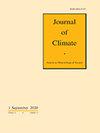Generation mechanisms of SST anomalies associated with the canonical El Niño focusing on vertical mixing
IF 4
2区 地球科学
Q1 METEOROLOGY & ATMOSPHERIC SCIENCES
引用次数: 0
Abstract
Abstract The mean vertical advection of anomalous vertical temperature gradient is considered as the dominant generation mechanism of positive sea surface temperature (SST) anomalies associated with the canonical El Niño. However, most past studies had a residual term in their heat budget analysis and/or did not quantify the role of vertical mixing even though active vertical turbulent mixing in the upper ocean is observed in the eastern equatorial Pacific. To quantitatively assess the importance of vertical mixing, a mixed layer heat budget analysis is performed using a hindcast simulation forced by daily mean atmospheric reanalysis data. It is found that when the mixed layer depth is defined as the depth at which potential density increases by 0.125 kg m−3 from the sea surface, the development of positive SST anomalies is predominantly governed by reductions in the cooling by vertical mixing, and their magnitude is much larger than those by vertical advection. The anomalous warming by vertical mixing may be partly explained by an anomalous deepening of the thermocline that leads to a decrease in the vertical temperature gradient, giving rise to suppression of the climatological cooling by vertical mixing. Also, an anomalously thick mixed layer reduces sensitivity to cooling by the mean vertical mixing and contributes to the anomalous SST warming. On the other hand, the dominant negative feedbacks are attributed to both anomalous surface heat loss and anomalous deepening of the mixed layer that weakens warming by the mean surface heat flux.以垂直混合为重点的典型厄尔尼诺现象相关的海温异常的生成机制
摘要 异常垂直温度梯度的平均垂直平流被认为是与典型厄尔尼诺现象相关的正海面温度(SST)异常的主要生成机制。然而,尽管在东赤道太平洋观测到了上层海洋活跃的垂直湍流混合,但过去的大多数研究在热预算分析中都有一个残差项,并且/或者没有量化垂直混合的作用。为了定量评估垂直混合的重要性,利用大气再分析日均值数据的后报模拟进行了混合层热量收支分析。结果发现,当混合层深度被定义为潜在密度从海面增加 0.125 kg m-3 的深度时,正 SST 异常的发展主要受垂直混合冷却减少的影响,其幅度远远大于垂直平流的影响。垂直混合异常增温的部分原因可能是热跃层异常加深,导致垂直温度梯度减小,从而抑制了气候学上的垂直混合冷却。此外,异常厚的混合层降低了对平均垂直混合冷却的敏感性,也是海温异常变暖的原因之一。另一方面,主要的负反馈归因于异常地表热损失和异常混合层加深,这削弱了平均地表热通量的增暖作用。
本文章由计算机程序翻译,如有差异,请以英文原文为准。
求助全文
约1分钟内获得全文
求助全文
来源期刊

Journal of Climate
地学-气象与大气科学
CiteScore
9.30
自引率
14.30%
发文量
490
审稿时长
7.5 months
期刊介绍:
The Journal of Climate (JCLI) (ISSN: 0894-8755; eISSN: 1520-0442) publishes research that advances basic understanding of the dynamics and physics of the climate system on large spatial scales, including variability of the atmosphere, oceans, land surface, and cryosphere; past, present, and projected future changes in the climate system; and climate simulation and prediction.
 求助内容:
求助内容: 应助结果提醒方式:
应助结果提醒方式:


